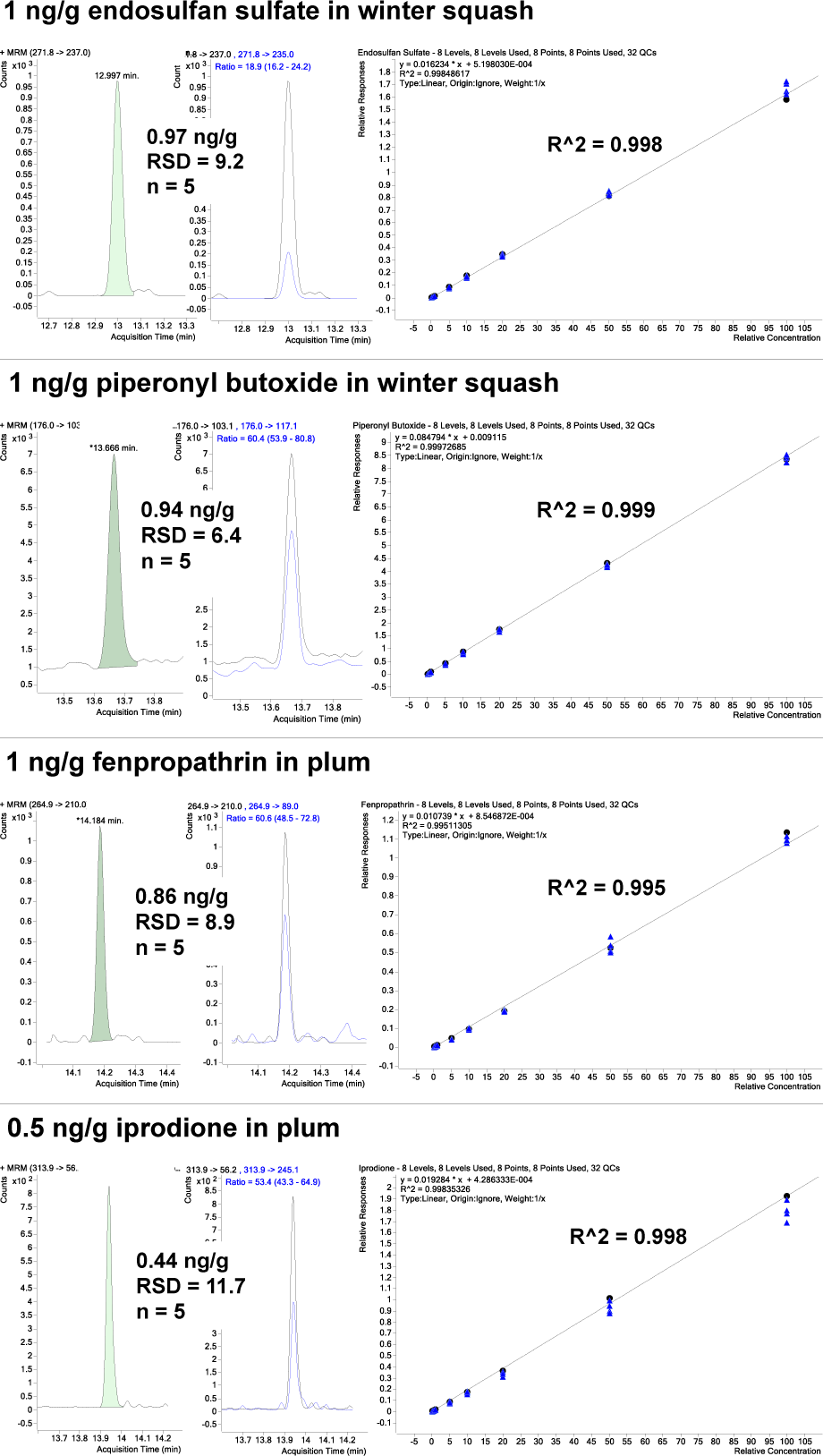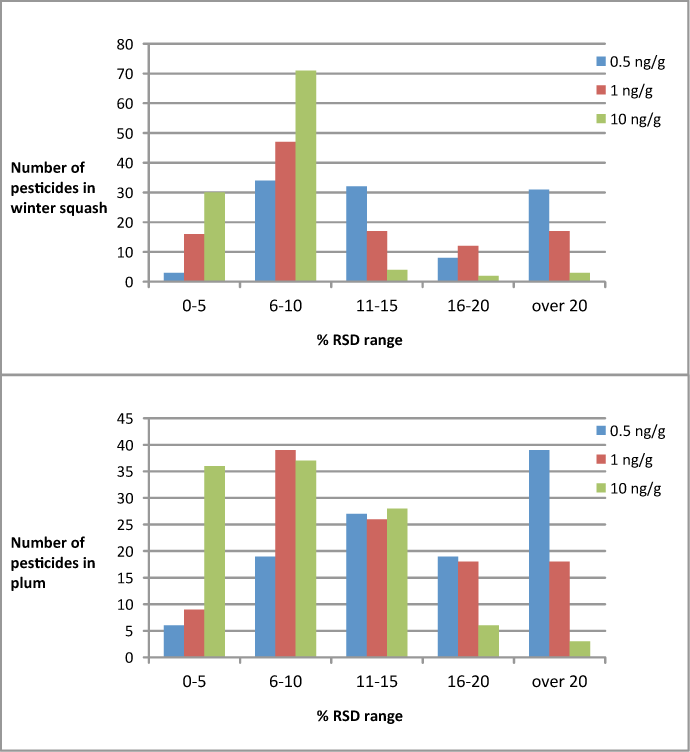Access Agilent eNewsletter, January 2014
>> Update My Profile | Subscribe to Access Agilent | Article Directory
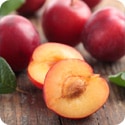
Reduce detection limits for pesticide residues in foods with the new Agilent 7000C Triple Quadrupole GC/MS System
By Melissa Churley
Agilent Senior Applications Scientist
As required detection limits for food contaminants continue to drop, you need increasingly sensitive instrumentation. A recent study showed that the new Agilent 7000C Triple Quadrupole GC/MS system, designed to deliver accurate results in complex sample matrices, fulfills this need.
The continuing effort to reduce detection limits for pesticide residues in foods has proved to be a challenge to analytical scientists worldwide. According to SANCO/3346/2001 rev 7, maximum residue limits (MRLs) are “based upon residue levels from trials in which the pesticide was used on the crop at the correct application rate and waiting time. To check if this level is acceptable for consumer exposure, intake calculations for various consumer groups are made, both for acute and chronic intake. If the level is acceptable, the MRL is set by the Commission. If not, the LOD (Limit of analytical determination) is applied.”
This default or threshold value is set to 0.01 mg/kg, or 10 ng/g, in the European Union (EU) and in Japan; however, scientists want to collect pesticide residue data at levels as low as possible in baby food to assess exposure in this sensitive population. The goal of our recent study was to evaluate the performance of the new Agilent 7000C Triple Quadrupole GC/MS for pesticide residue analysis at levels less than 10 ng/g.
Validated extraction and analysis methods
The extraction and analytical methodologies we used had been fully validated in several state laboratories in the United States with the Agilent 7000 Series Triple Quadrupole GC/MS and are described in the Agilent GC/MS/MS Pesticide Residue Analysis Guide and in Agilent Application Note 5990-1054EN. You can get the analysis guide by contacting your Agilent sales representative or product specialist.
For maximum GC/MS sample path inertness, we used the following components:
- Agilent J&W HP-5ms Ultra Inert GC columns in dimensions of 5 m × 0.25 mm × 0.25 µm and 15 m × 0.25 mm × 0.25 µm (G3903-61005, 19091S-431UI)
- Agilent Ultra Inert 2 mm dimpled liners (5190-2297)
- Agilent UltiMetal Plus Flexible Metal Ferrules at the Purged Ultimate Union used for column backflushing
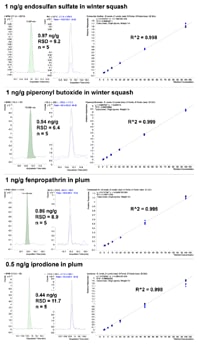 Enlarge
Enlarge
Figure 1. Excellent results for representative pesticides, including those commonly incurred in winter squash and plum, at the estimated LOQ.
Matrices studied ranged from that of mid-difficulty, in the case of winter squash, to difficult in the case of plum. We prepared 1 ng/g samples with Agilent AOAC QuEChERS extraction and dispersive kits (5982-5755, 5982-5058). We prepared calibration standards for a mixture of 110 pesticides by spiking extracted matrix at 0.1, 0.5, 1, 5, 10, 20, 50, and 100 ng/g. Then we injected sets of standards consecutively either three or five times with calibration on the middle set in the sequence. We used a linear curve fit for eight calibration points for all pesticides studied.
Results demonstrate excellent linearity
Calibration sets yielded values for R2 that were better than 0.99 in all cases.
Figure 1 shows quantitative results at the estimated limit of quantitation (LOQ) for commonly incurred or representative pesticides in winter squash and plum. We estimated LOQs based on criteria that included a resultant %RSD ≤ 20 (n=5) for calculated amounts and S/N >10. The average calculated amounts and %RSDs are shown.
Achieve reliable quantification
We estimated LOQs based on the consecutive injection of five calibration sets of eight levels. Table 1 provides a comparison of estimated LOQ values for selected pesticides, including the most challenging, and EU maximum residue limits (MRLs). Reliable quantification was achieved at well below EU MRLs for all pesticides analyzed in winter squash and plum with few exceptions (only 3% of LOQs in each matrix were > MRL). Of 110 included pesticides, 84 had resultant estimated LOQs ≤ 1 ng/g and LOQs were ≤ 5 ng/g for 100 of the pesticides analyzed in winter squash. In plum, 83 pesticides were estimated to have LOQs ≤ 1 ng/g and 100 had LOQs ≤ 5 ng/g. (Although not used in this study, the addition of deuterated ISTDs for base-sensitive pesticides captan and folpet is recommended in order to control recovery and assure reliable results, especially for larger batches of 40 or more injections).
Pesticide |
EU MRL in Winter Squash (ng/g) |
Estimated LOQ (ng/g) |
EU MRL in Plum (ng/g) |
Estimated LOQ (ng/g) |
|---|---|---|---|---|
captan |
20 |
1 |
7000 |
51 |
cypermethrin |
200 |
20 |
2000 |
20 |
deltamethrin |
200 |
1 |
100 |
5 |
dichlobenil |
10 |
0.1 |
10 |
0.5 |
endosulfan, alpha- |
502 |
5 |
502 |
10 |
endosulfan sulfate |
502 |
1 |
502 |
0.5 |
fenpropathrin |
10 |
1 |
10 |
1 |
folpet |
1000 |
0.5 |
20 |
51 |
flusilazole |
20 |
0.1 |
100 |
0.5 |
iprodione |
1000 |
0.5 |
3000 |
0.5 |
phenothrin I and II (summed) |
50 |
5 |
50 |
10 |
piperonyl butoxide |
103 |
1 |
103 |
5 |
resmethrin I and II |
1004 |
10 |
1004 |
5 |
trifluralin |
10 |
0.5 |
10 |
0.5 |
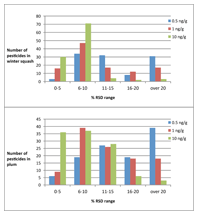 Enlarge
Enlarge
Figure 2. Distribution of %RSDs (all are based on n = 5) at 0.5, 1, and 10 ng/g in a) winter squash and b) plum.
1 Estimation based on n = 3 (three calibration sets equal to 24 injections)
2 Sum of alpha, beta isomers and endosulfan sulfate
3 Not listed (default MRL of 0.01 mg/kg applies)
4 Sum of isomers
MRLs from Regulation (EC) No 1107/2009, MRLs updated 8/10/2013 (EU Pesticides database)
Table 1. EU MRLs and estimated LOQs for some challenging pesticides.
More than 80% of pesticides yielded %RSDs ≤ 20 at the 1 ng/g level
Figure 2 shows the number of pesticides in winter squash (a) and plum (b) with given %RSD values based on calculated amounts at three concentrations: 0.5, 1 and 10 ng/g. We obtained RSD values from five consecutive injections of a set of eight calibration standards. Of 110 pesticides tested, 92 pesticides in winter squash and 92 in plum yielded %RSDs less than or equal to 20 at a concentration of 1 ng/g.
With the Agilent 7000C Triple Quadrupole GC/MS system, you can quantitate the majority of pesticides we studied in winter squash and plum at or below the threshold of 10 ng/g. If you need a rugged, reliable instrument with sensitivity like this, learn more today.
>> Update My Profile | Subscribe to Access Agilent | Article Directory
